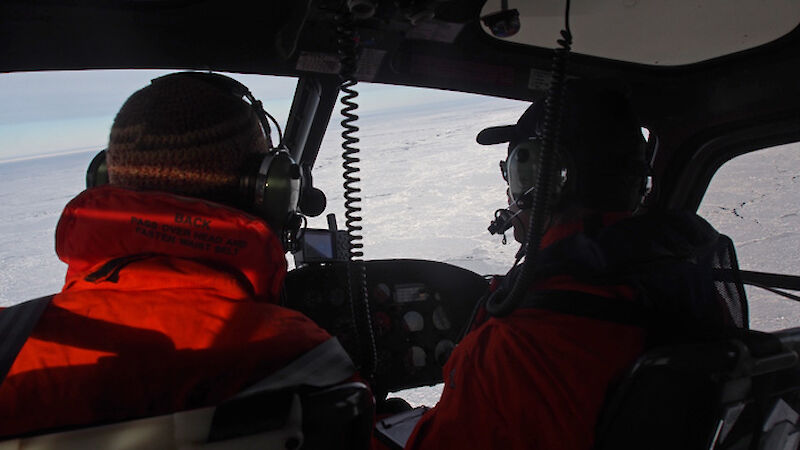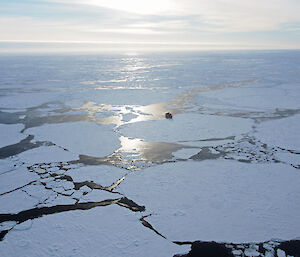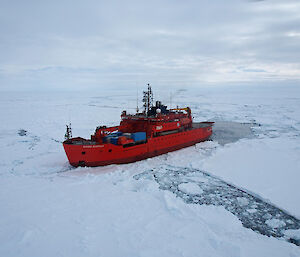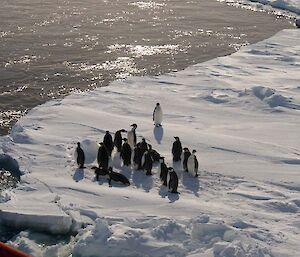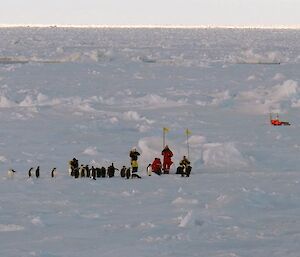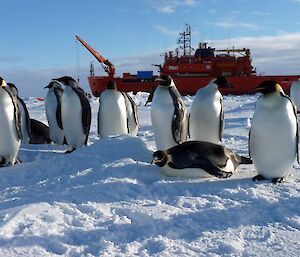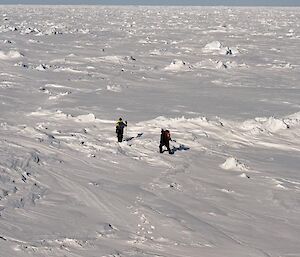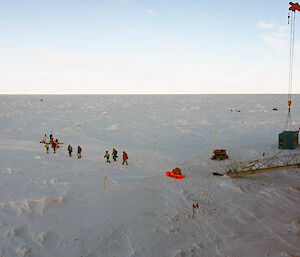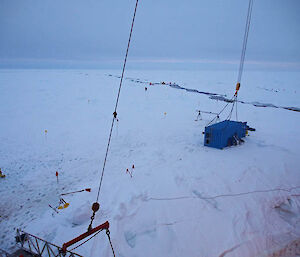Friday 28 September 2012
How many people get to start their day with a helicopter flight across Antarctic sea ice, chill with a bunch of emperor penguins after lunch and witness a rescue team in action when a group of scientists become separated from the ship by a crack in the ice? Tuesday 25 September was certainly a day this ship’s complement won’t forget, for many different reasons.
Antarctica sparkled in the morning. At 9:00 am Voyage Chief Scientist, Dr Klaus Meiners, and I did a helicopter reconnaissance to search for a suitable ice floe on which to begin scientific work. Klaus was looking for a single floe, of a size and thickness that would accommodate a 200 m scientific ‘transect’. He found one some 5 miles south of the ship and we steamed towards it over the next few hours.
In the meantime, the second helicopter, also known as the (very expensive) ‘flying toolbox’, conducted a test flight to check all the high-tech equipment on board that will be used to collect data on sea ice thickness and snow cover. The helicopter has hundreds of thousands of dollars of instrumentation built into it, including a high resolution, medium format, digital camera for aerial photos, a pyrometer to measure surface temperature, a scanning laser system used in combination with a radar to determine sea ice and snow cover properties and to measure the elevation of snow and sea ice above the ocean surface, an inertial navigation and global positioning system to pinpoint the attitude and location of the helicopter in space, and a microwave radiometer from our Japanese colleagues (more on all this in a later blog).
There was a buzz in the air when we reached our first ice station as expectant scientists who had been cooped up all week were finally free to step onto the ice. Klaus and Field Training Officer Christian Gallagher tested the floe first, drilling down into it to check its thickness and doing a general recce of the snow and ice conditions. The report back was that there was a lot of snow and a few areas of slush, but there was plenty of good stuff to sink data loggers and drill bits into.
Red and yellow flags were used to mark out the 200×200 m transect in which some scientific teams would work. Then containers were craned over the side of the ship and an orderly procession of teams, towing their sleds of equipment, stepped onto the ice and dispersed.
With all this noise and activity we had attracted a group of about 17 curious emperor penguins. These beautiful, big, fat birds spent a lot of time diving in the open water at the back of the ship, but once the scientists stepped on to the ice, the penguins decided to take a closer look. Within moments one team of scientists was surrounded, and outnumbered, by the group. The penguins moved between teams checking that the work was being conducted in a rigorous fashion and posing for group photos.
After all this general joie de vivre, Antarctica decided to remind us that we are here on nature’s terms. A number of people had already expressed a vague feeling of uneasiness working on the floe and watchers on the bridge had decided to call everyone back to the ship. Mere moments after this decision, at about 8:20 pm, the ice floe suddenly cracked in two places. Three horn blasts were sounded to evacuate people from the floe but three people were separated on the other side of the crack, with about 3 m of ocean between them and the main part of the floe.
Just days before, a ‘first response’ team of people with various training and experiences in rescue and first aid had been assembled and had discussed the response to this exact scenario. Members of this team promptly dispatched a quad bike carrying a ‘rescue bridge’ to the site. This bridge is essentially a large Thermarest (a type of camping mattress), which inflates to about 5m and is stable and strong enough for people to walk or crawl across.
Within about 30 minutes of the drama unfolding, our three team members were safely back on the main ice floe, along with their scientific equipment.
The affected scientists and those involved in the rescue operation have since been debriefed and the incident picked apart so that we can learn from the experience and improve our response to similar incidents in the future. While all precautions are taken and safety is drilled into us, the fact is we are working in a changeable and unpredictable environment. We must be prepared, trained, alert and aware.
We are now moving deeper into the ice and into ice floes that are more consolidated. Aerial images taken from the flying toolbox have identified a couple of promising floes. A few light-hearted puns have helped ease the tension wrought by Tuesday’s events, with the Chief Scientist heard to say ‘Let’s have another crack at an ice station tomorrow’, our Data Manager reminding scientists not to ‘let any of your data fall through the cracks’, and from our Voyage Leader ; ‘we’ll just go with the floe’.

